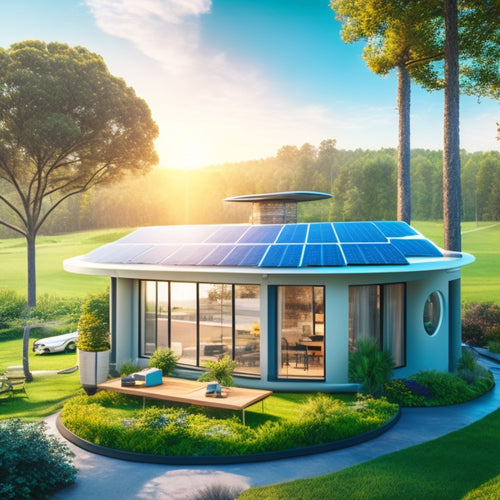
3 Home Microgeneration Tips for Sustainable Living
Share
You're taking a significant step towards reducing your carbon footprint and embracing sustainable living by exploring home microgeneration options. Start by utilizing renewable energy sources like solar panels or wind turbines, which can be installed on your roof or in your backyard. Next, optimize your energy consumption patterns by adopting simple habits like turning off devices, using energy-efficient bulbs, and adjusting your thermostat. Finally, guarantee a seamless integration of your microgeneration system by considering factors like energy output, storage, and regular maintenance - and that's just the beginning of your expedition to sustainable living.
Key Takeaways
- Install solar panels with high-efficiency cells to maximize energy generation and reduce your carbon footprint effectively.
- Conduct an energy audit to identify inefficiencies in your home and optimize energy usage for sustainable living.
- Implement a hybrid approach to microgeneration, combining different renewable energy sources to minimize costs and optimize energy output.
- Regularly maintain your microgeneration system, including cleaning solar panels, to ensure optimal performance and energy output.
- Choose a professional installation to ensure correct, safe, and efficient setup of your microgeneration system.
Harnessing Renewable Energy Sources
Your home can be a powerhouse of renewable energy, and it all starts with utilizing the right sources. You can generate electricity on-site with solar panels, which convert sunlight into energy. These panels can be installed on your roof or in your backyard, providing a clean and sustainable source of power.
For instance, high-efficiency photovoltaic cells can maximize energy generation, making them a great option for those looking to reduce their carbon footprint. Additionally, energy audits can help identify areas of inefficiency in your home, allowing you to optimize your energy usage and make the most of your renewable energy sources.
Another option is wind turbines, which capture the energy of wind to generate electricity. Although they require more space, wind turbines can be an effective way to supplement your energy needs.
Optimizing Energy Consumption Patterns
The key to maximizing the benefits of home microgeneration lies in optimizing your energy consumption patterns. This involves making behavioral changes to reduce your energy usage and increase energy efficiency.
| Energy-Efficient Habits | Benefits | Tips |
|---|---|---|
| Turn off lights, appliances when not in use | Reduces standby power consumption | Make it a habit to switch off lights, TVs, and computers when not in use |
| Use energy-efficient light bulbs | Saves energy and lasts longer | Replace traditional bulbs with LED or CFL bulbs |
| Adjust thermostat settings | Optimizes heating and cooling | Lower thermostat in winter, raise in summer |
| Run full loads in washing machine and dishwasher | Reduces water and energy consumption | Plan your laundry and dishwashing days |
| Unplug chargers when not in use | Eliminates standby power consumption | Unplug phone, laptop chargers when not charging |
Integrating Microgeneration Systems Seamlessly
Now that you've optimized your energy consumption patterns, it's time to integrate microgeneration systems into your daily life. When selecting a system, verify system compatibility with your existing infrastructure and energy needs.
Consider factors like energy output, storage capacity, and grid connection requirements. Additionally, adopting a hybrid approach can optimize energy usage, controlling consumption and minimizing costs and environmental impact energy efficiency strategies.
Regular maintenance, including cleaning, is also essential for solar panel performance and energy efficiency. During installation, follow best practices to verify a seamless integration.
Hire a professional installer who can assess your home's unique conditions and optimize system performance. They'll verify that your system is installed correctly, safely, and efficiently.
Proper installation will also help you avoid potential issues like energy losses, system downtime, and even safety hazards. By doing so, you'll be able to enjoy the benefits of microgeneration while maintaining your independence and freedom.
Frequently Asked Questions
What Are the Benefits of Microgeneration for Rural Communities?
You'll find that microgeneration offers rural communities energy independence, reducing reliance on external power grids and enhancing community resilience during outages, allowing you to thrive with self-sufficient, clean energy solutions.
Can I Install Microgeneration Systems in Rented Properties?
You're probably thinking, "But I'm a renter, not a homeowner." Don't worry, you still have tenant rights. While installation challenges exist, you can negotiate with your landlord or investigate portable microgeneration options, like solar-powered generators, to reduce your carbon footprint and energy bills.
How Do I Maintain and Repair Microgeneration Equipment?
You'll need to create a maintenance schedule to guarantee your microgeneration equipment runs smoothly; regularly inspect and clean components, and know how to troubleshoot common issues, so you can identify and fix problems quickly, saving time and money.
Are Microgeneration Systems Compatible With Smart Home Devices?
You'll be surprised to know that 70% of smart homes already integrate renewable energy sources! As you investigate microgeneration, you'll find that many systems seamlessly integrate with smart home devices, offering real-time monitoring and automation through smart technology compatibility.
What Government Incentives Exist for Microgeneration Adoption?
You'll find various government incentives to adopt microgeneration, including financial incentives like tax credits, renewable grants, and energy subsidies, as well as installation rebates and community programs that can help offset the initial investment costs.
Related Posts
-

Why Choose Recycled Paper for Earth-Conscious Business?
By choosing recycled paper, you'll greatly reduce your business's environmental impact. You'll lower your carbon foot...
-

3 Ways Wind Power Boosts Home Value
Living near a wind farm can enhance your property's value in three significant ways. To begin with, proximity to wind...
-

Gamify Your Home's Energy Generation and Savings
You're taking the next step in optimizing your home's energy generation and savings by utilizing the power of gamific...


